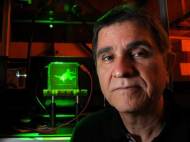Researchers made progress in holographic image animation
 A team from University of Arizona College of Optical Sciences, led by professor Nasser Peyghambarian, developed a new type of holographic telepresence that allows the projection of a three-dimensional, moving image without the need for special eyewear such as 3D glasses or other auxiliary devices. The technology is likely to take applications ranging from telemedicine, advertising, updatable 3D maps and entertainment to a new level.
A team from University of Arizona College of Optical Sciences, led by professor Nasser Peyghambarian, developed a new type of holographic telepresence that allows the projection of a three-dimensional, moving image without the need for special eyewear such as 3D glasses or other auxiliary devices. The technology is likely to take applications ranging from telemedicine, advertising, updatable 3D maps and entertainment to a new level.
“At the heart of the system is a screen made from a novel photorefractive material, capable of refreshing holograms every two seconds, making it the first to achieve a speed that can be described as quasi-real-time”, said Pierre-Alexandre Blanche, an assistant research professor in the UA College of Optical Sciences and lead author of the paper published in Nature.
The prototype device uses a 10-inch screen, but Peyghambarian’s group is already successfully testing a much larger version with a 17-inch screen. The image is recorded using an array of regular cameras, each of which views the object from a different perspective. The more cameras that are used, the more refined the final holographic presentation will appear.
That information is then encoded onto a fast-pulsed laser beam, which interferes with another beam that serves as a reference. The resulting interference pattern is written into the photorefractive polymer, creating and storing the image. Each laser pulse records an individual “hogel” (short for holographic pixel) in the polymer. The hologram fades away by natural dark decay after a couple of minutes or seconds depending on experimental parameters. Or it can be erased by recording a new 3D image, creating a new diffraction structure and deleting the old pattern.
The overall recording setup is insensitive to vibration because of the short pulse duration and therefore suited for industrial environment applications without any special need for vibration, noise or temperature control.
One of the system’s major hallmarks never achieved before is what Peyghambarian’s group calls full parallax: “As you move your head left and right or up and down, you see different perspectives. This makes for a very life-like image. Humans are used to seeing things in 3D.”
The work is a result of a collaboration between the UA and Nitto Denko Technical (NDT), a company in Oceanside, Calif. NDT provided the polymer sample and media preparation. “We have made major advances in photorefractive polymer film fabrication that allow for the very interesting 3D images obtained in our upcoming Nature article,” said Michiharu Yamamoto, vice president at NDT.
Potential applications of holographic telepresence include advertising, telemedicine, updatable 3D maps and entertainment. The system has an advance over computer-generated holograms, which place high demands on computing power and take too long to be generated to be practical for any real-time applications.Currently, the system can present in one color only, but Peyghambarian and his team have already demonstrated multi-color 3D display devices capable of writing images at a faster refresh rate, approaching the smooth transitions of images on a TV screen.









Leave your response!